#Sümbül Agha
Text
I like the conversation between Hürrem and Mihrimah in Episode 114 about Sümbül’s freedom. “Not everyone is as lucky as you Mihrimah. I don’t expect you to understand, because you realize the value of freedom when you lose it”.
19 notes
·
View notes
Text
As was mentioned in a discussion I had earlier, in the first season, a murder of a concubine carried a significant weight that seemed to diminish in later seasons.
We were introduced to the concubine that was murdered, she was her own person. Everyone reacted to the murder with shock, which also includes Valide and Hatice, before they themselves started murdering concubines for their own gain, to win in a fight with Hürrem.., Whereas in the later seasons when a concubine was murdered, while it wasn't a happy moment, it didn't seem like a big deal either, probably because like I said the dynasty members themselves had usually been the murderers. Basically everyone would move on like it's an every day occurence (which in a way was i guess, this only adding to my point).
Season one introduced us to all of the main characters and their relationships really well, they were believable and it was easy to get invested in the show. There seemed to be rules and balance in the harem (which stopped being the case later, once the concubines' lives have started to get used as an own). Through Hürrem we were introduced to kalfas (specifically one that I'll mention more later), aghas/servants in general and other concubines. We saw more of their personal lives/personalities, they weren't only one dimensional plot devices like all of the concubines in later seasons became. Could that be because Hürrem became a sultana so there was no way to see more of them, since she had no reason to really interact and hang out with other concubines anyymore (even though the show does show that Hürrem does like befriending her servants)? It's either an intentional choice by the show aimed to emphasize how distanced she had become from the servants the more powerful she got, which I highly doubt, or the writers couldn't think of another way to show more of concubines' lives or they simply forgot about them/didn't really care for them.
Now, aghas were handled alright (when they weren't completely being reduced to comic relief) even later in the show, in s4 we actually finally got Sümbül's backstory.
Characters the show were was overall more aware of how bad it really was for servants and other women there, which we see in this scene of Mahidevran and Hatice talking about how the women of harem are only worth of being treated as human beings if they give birth to a prince.
We see the show criticising the life of servants there a bit through Ibrahim's reuniting with his family arc as well.
Most of the criticism was shown through Viktoria's arc though, firstly as a condemnation of Süleyman and by being the closest the show ever gets to the real criticism of the empire as @hurrempilled mentioned. Viktoria truly suffered a lot there.
Even Gülfem's character and her dynamic with Süleyman was more fleshed out, specifically in this scene which I really liked, I wish the show focused on her character more
Now, Nigar kalfa has to be the best written character in season one, like genuinely the smartest, most mature person there. Firstly, it was such a good idea to give Hürrem a mentor, her relationship with Hürrem was so nice, having Nigar advise her, hang out with her.. I do hate how the show ruined them. And not only do I dread watching post Leo's death episodes because of the end of her friendship with Hürrem, but also because of her character change. In the final episodes of season one we see her threaten Mahidevran, a sultana, in such a smart and confident way, to have her promoted to a head kalfa.. but then unfortunately that storyline never really goes anywhere. Now, I don't think that Nigar's character was bad in season 2, but I didn't like how they handled her arcs, firstly by switching her from one palace to another to progress her affair with Ibrahim, and then kinda reducing her to only that, being Ibrahim's lover/being in love with him. We could've had that storyline, but also the smart head kalfa arc continuation. And yeah, how season 3 handles her is pretty bad, by s3b I was confused on what even her goal was other than being writers' plot device. I mention her, because she is one of the servants that was handled so well in season 1 and then started going downhill unfortunately. But yeah, this isn't only the case with her character
What @faintingheroine mentioned once, it would've been great if there were servants that were more rebellious, didn't just completely go along with loyally serving the dynasty. Which is also something that I love about s1 Nigar, she was never just blindly loyal like everyone else, she worked/did things for herself as well
#the only time where others would care about a murder or death was if a dynasty member died#magnificent century#muhteşem yüzyıl
11 notes
·
View notes
Text
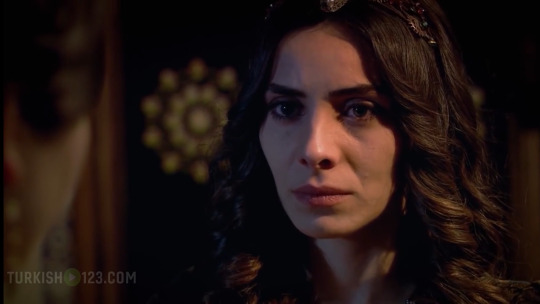
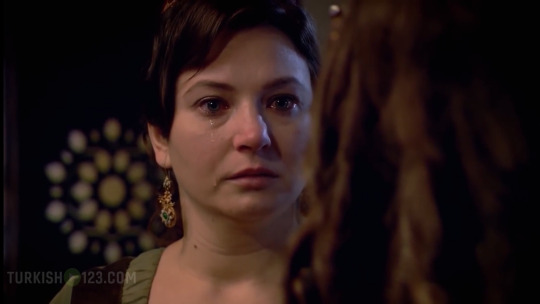

Live Sümbül-agha reaction

#please believe me when i say it's funnier when you remember how LONG these close-up shots last in soap operas#i had to watch Gülşah's tear roll down and everything
11 notes
·
View notes
Note
Ranking of Kalfas and Aghas in MC/K? (You can rank Kalfas and Aghas together or separately, your decision)
Ahhh... Asking only the easiest of questions, are we? Very well... (Again, I should probably add some after the rewatch, I don't remember everyone, blah blah, you know the drill.)
KALFAS
1. Nigar - You must've known she would end up here the second you asked that question. Yes, the writers haven't been kind to her. But trough hell or high water, in good writing and bad, Nigar was never not the smartest person in the room. She maintained some of her spark almost to the very end. Press f in chat for the best girl.
2. Cennet - I am very biased towards characters with very strong personalities, which is why Fatma was the best sultana of blood in my eyes. And Cennet has one hell of a personality. Even when the writing of other characters revolved solely around their relationship to Kösem (Halime was her antagonist, so she became a moustache-twirling villain, etc.), she maintained hers to the very end. It was in fact so strong she was apparently was able to seduce pretty boys like half her age just trough it. A legend, I tell ya.
3. Daye - A solid third place for a solid lady. Nothing but respect for MY chief kalfa.
4. Afife - She's... Likeable. Also has that "tough but fair" thing going on that makes her different enough from Daye to make me mildly intrigued with her character. Not my favourite by any means, but pretty good.
5. Menekşe - Our goth sultana's preppy sidekick isn't, alas, very deep or interesting. But she's ride or die for Halime, and as someone who is also mostly ride or die for Halime, I can't not appreciate that. Besides, at least she has some consistent personality. That's not a given with these girls.
6. Gülşah - She had been in the show for so long and had such a strong, consistent presence that I can't help myself from becoming a little bit fond of her. She's a horrible person, but she would do anything for Mahi's pretty eyes, and can you blame her? Her fall from Mahidevran's good graces was actually kind of sad. That said, for all of my sympathies, she does undeniably suck.
7. Fahriye - In principle, she should be pretty fascinating, going from hating Hürrem for relatively understandable reasons to unconditional loyalty to her. Unfortunately, the show never allows us much insight into her thoughts and feelings, especially during her defection to Hürrem. She is just kinda stuck with her after the assassination attempt. Apparently, she develops some sympathies for Hürrem after hating her guts... Why? And after the defection, she doesn't seem to have much personality at all. What a waste.
8. Fidan - Similar problem, except where Fahriye was kinda interesting as a fighter and Mahidevran's top agent, Fidan is just... Some lady that does what Hürrem tells her, untill Ayşe Hafsa forces her to turn away from Hürrem. She then starts serving Mahidevran, in fact, she becomes her most loyal attendant... For some reason. Also, her friendship with Fatma seems to exist solely for Fatma to have someone to talk to. *yawn*
9. Dudu - If you sucked away everything that made Daye and Afife distinct, you would get Dudu. Even as a big fan of Kösem season 1 I have no opinion of her, which is saying something.
AGHAS
1. Sümbül - I mean, this is kind of a honorary position, isn't it? Sümbül wasn't always the kindest or funniest, and could at times be annoying. But much like Hürrem and Mahi, he stuck for the long haul, and for all of the moments good and bad, he deserves the first place.
2. Bülbül - How did this precious little cinnamon roll end up in the service of the most evil sultana of her era is still a mystery to me. Romantic love is the only explanation. Either way, a middle-aged man has no right to be this adorable. Your honor, I love him.
3. Gül - This was a very close race. He's a lot like Bülbül, but with a bit of a mean streak and the level of devotion that crosses over to asskissing. Still, he's pretty funny, and most of the time a nice person, except where his legendary rivalry with Sümbül is concerned.
4. Mercan - He's also close to the third and second place, and in many ways is hard to compare to the others. Which, I give him credit even just for the novelty; where most prominent eunuchs in the show are loud and effeminate, to suddenly have this silent gigachad stand next to fucking Sümbül... Well, he's nothing if not memorable. His stoic exterior hides a heart that beats for but one thing - his mistress... But I'd better stop before this turns into a fanfic.
5. Kiraz - I'll just say that if the writers needed a small annoying creature following Afife's every step, they could've just given her a dog.
6. Haci - He has two modes: asshole and Kösem's lackey. Needless to say, I don't like either of them. His rivalry with Bülbül is a pale shadow of Sümbül and Gül, mostly consisting of Haci being a dick for no reason and Bülbül being annoyed by it. Which, how dare he be mean to my precious Bülbül?!
11 notes
·
View notes
Text
Non real life sultanas
A little Christmas surprise post comes. One of my most popular videos on Youtube was the one, where I gathered non-historical characters, explaining how fictional or how historical they were, and if there was a real historical person behind them as an inspirer. Now, for Christmas, I would like to summarize for you the main fictional characters of the Muhteşem Yüzyil series.
Several fictional characters were present in the Muhteşem Yüzyil series, many from the very first minutes. The presence of some fictional characters was forgivable, as we were left with very little detailed information about the harem of Sultan Suleiman I. Thus, for example, the characters of Sümbül Agha, Gül Agha, Mercan Agha, and other eunuchs, although not portraying historical characters, were necessary for the dramaturgy of the series. Sümbül's character was the most important among the eunuchs and perhaps this is why many of us may think that Hürrem actually had such a close friend in the person of the chief eunuch. However, this is not true. During Suleiman's reign, many chief eunuchs took turns, and none of them were known to be particularly close to Hürrem. Of Hürrem's close servants, only one is known by name, a woman named Nevbahar. The characters of Nigar Kalfa, Gülsah Hatun, Fidan Hatun, Daye Hatun, Fahriye Kalfa were similar to Sümbül. None of them were historical, but surely every sultana had their own trusted servants, as they showed in the series. Like the eunuchs and kalfas, the concubines of Prince Mustafa and Prince Bayezid, Ayşe, Rana, Defne or Rumeysa Hatun, can also be considered forgivable fictional characters. We do not know anything about the harem of the two princes as neither of them had a major consort and as their children were born from different women.

However, there were also characters who were written into the story just for the sake of the drama. Which of these characters was acceptable is up to everyone and feel free to write your opinion about them in a comment here or on another platform! So here's the long-awaited list:
Sadika Hatun
Sadika was a Hungarian woman in the series whose husband was killed by Sultan Suleiman on the day of their wedding. Sadika then became the spy of the Hungarian king, Lajos II and she traveled to Istanbul to personally avenge her husband’s death. Matrakci Nasuh Efendi then, by chance, meets the girl and helps her get into the harem, where she immediately joins Ayşe Hafsa Valide Sultan's service and then becomes Hatice Sultan’s chief servant. During her job, of course, she gets close to Suleiman's bed several times, and then she had the opportunity to attack the sultan. However, she does not succeed, Suleiman survives, and Sadika is thrown in the Bosphorus.
In reality, this story would not be possible at all. Even if we assumed that Sadika really existed and Suleiman actually killed her husband, she would not have been able to get into the Sultan's harem and take revenge. On the one hand, Sadika was already a married woman, an adult woman. Such women could not enter the harem, only virgin, child girls could become the sultan's later concubines. However, even if Sadika had somehow been able to get in the harem, a long education would have awaited her before she could join the Valide Sultan's service. While there may have been some exceptional cases where older or non-virgin women wanted to be gifted to the Sultan, these are special cases. Such was the case, for example, when Hayreddin Barbarossa wanted to kidnap the beautiful Giulia Gonzaga, a widowed Italian noblewoman known far and wide, to send her to the Sultan's harem as a gift. In the end, he didn’t succeed, but even if he did, we don’t know if the sultan would had ever taken the woman to his bed.
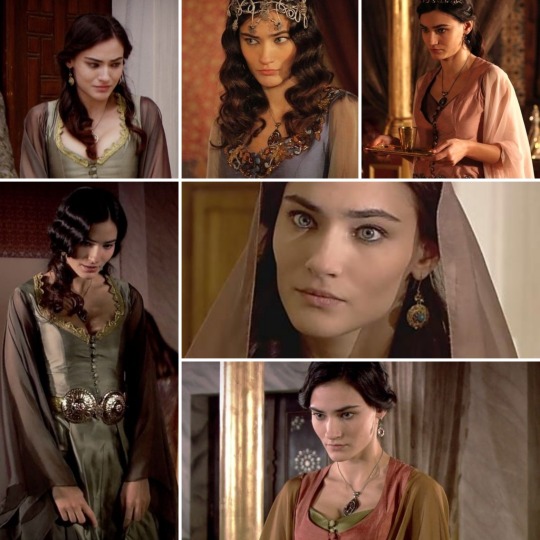
Leo
In the series, he was the love of Hürrem from their youth. Leo came to Istanbul with the goal of finding her former sweetheart. Leo is a talented artist who, with the help of Nasuh Efendi (ahh Nasuh brought all the good people near to the Sultan…) will become the painter of Sultan Suleiman and Pargali Ibrahim. His former relationship with Hürrem will soon be revealed to Pargali Ibrahim, who is thus trying to blackmail Hürrem. Hürrem repeatedly begs Leo to leave the capital, but the man remains, which eventually leads to his death.
In reality, Hürrem - and all the other concubines - were taken into Ottoman captivity as little girls, so it is out of the question that they would have had a love or a fiance. And even if they had, they could never have found them. Nasuh Efendi, though one of the greatest suckers in the series - yet the dearest character - was not like that in reality at all, but he was a wonderful scholar who, by the way, was not so closely friends with either Sultan Suleiman or Pargali Ibrahim.
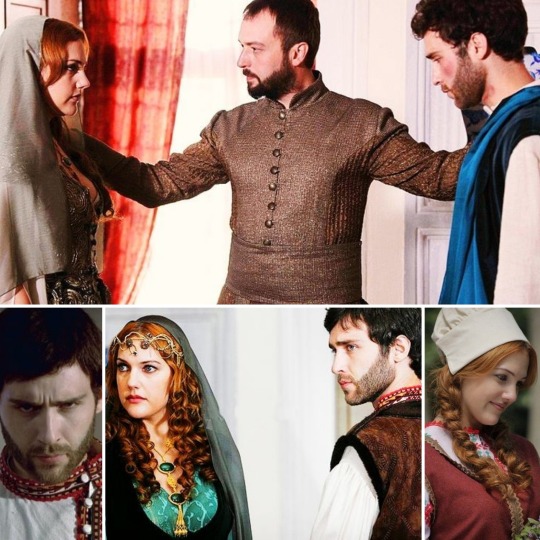
Princess Isabella
Princess Isabella Fortuna was a Spanish noble lady in the series who was on a ship to her future husband, the Austrian prince, when she was captured by Ottoman pirates and was taken to Istanbul to Sultan Suleiman. At first, Suleiman was only interested in the princess for political reasons, but later he fell in love. Princess Isabella initially resisted Suleiman's approach with all her cartilage, but over time she fell in love with the sultan and became his lover. This, of course, Hürrem could not stand and did everything she could to get rid of the princess who was eventually sent home by Suleiman himself.
In reality, of course, such a situation would have been unthinkable. Even assuming that Isabella existed and was captured by pirates, no princess raised in the Catholic faith would have voluntarily become the concubine of a Muslim sultan, she would have committed suicide instead. Let us not forget that Suleiman was loyal to Hürrem from the 1520s onwards, so in reality there was not a single woman who could make hard time for Hürrem during her decades-long relationship with Suleiman. Isabella Fortuna, on the other hand, never existed. Surprisingly, however, they could have patterned her from a real character. There was an Isabella of Castile in this period who was born in 1518 as the child of the widowed Queen of Aragon, Germaine of Foix and Charles V, but she was never captured by Ottoman pirates and was never the bride of the Austrian prince. Isabella's existence was kept secret by her parents all her life, only her mother's testament revealed that she ever existed. It is also known from there that Isabella died young in 1537.
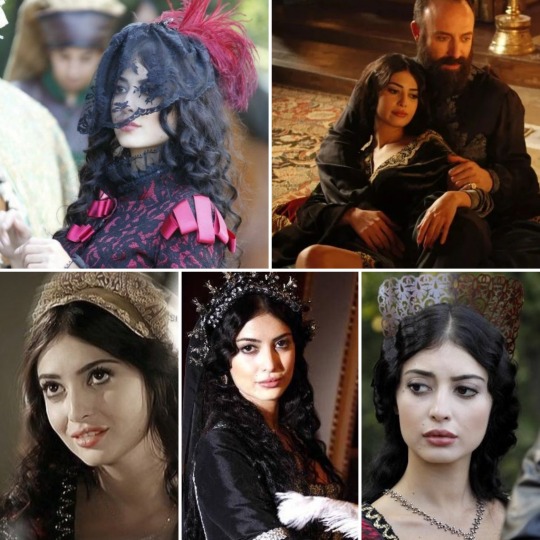
Aybige Hatun
In the series, Aybige was the niece of Ayşe Hafsa, and so the daughter of the Crimean Sahib Giray khan. Aybige originally only came to visit her aunt in Istanbul, but later Hafsa Sultan wanted to see her as the wife of her favorite grandson, Prince Mustafa. However, Aybige was in love with Bali Bey and Mustafa longed for someone else aksi. Bali Bey was eventually almost executed for their love, and Aybige returned to Crimea with her father in the end.
Aybige’s storyline makes mistakes at almost every point. First, Ayşe Hafsa was never the sister of the Crimean khan, so the daughter of the Crimean khan could not have been her niece either. In addition, although Sahib Giray Khan had several daughters, none were called Aybige and none of his daughters ever traveled to Istanbul. The only true point in the whole storyline is that Sahib Giray Khan really collaborated with Sultan Suleiman in his Moldovan war. It is also important to mention Bali Bey at this point. Although Bali Bey was a real historical figure, there is not the slightest match between historical Bali Bey and the series Bali Bey. The real Bali Bey was not a romantic guy who fell in love with every second woman. Bali Bey was a cruel warlord. And if it comes to Bali Bey, let’s say a few words about Prince Mustafa as well. The idea of wanting to marry Mustafa to a khan’s daughter is completely absurd! Since the reign of Sultan Mehmed II, princes have been forbidden to marry anyone, so Prince Mustafa has not been allowed to marry anyone either. And the fact that Suleiman would have supported the idea - even if such a marriage had been able to occurre at all - is an even greater absurdity. Suleiman did not want Mustafa as his heir, so he would never have given him as much power as the support of the Crimean khan.
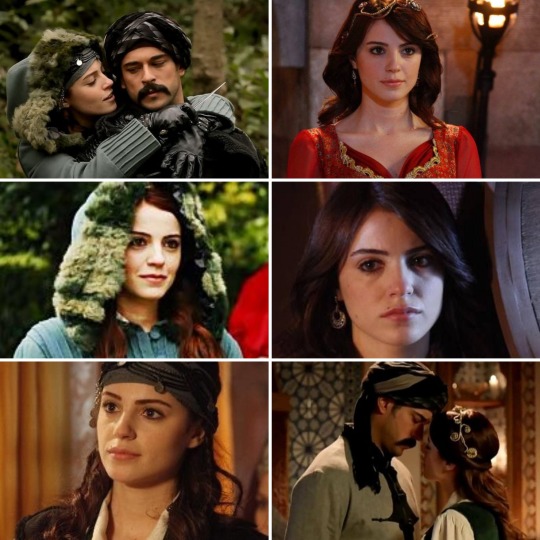
Firuze Hatun
In the series, Firuze was a Persian spy who, with her amazing abilities, was able to heal the pains of the sick Prince Cihangir, earning the love of Hürrem Sultan. Firuze, however, thanked Hürrem kindness in a disgusting way, and became Suleiman's secret lover, whom the sultan fell in love with. In the end, Hürrem was only able to overcome Firuzen with a little, Firuze was eventually exiled from the palace so she could return to Persia.
In reality, Suleiman was loyal to Hürrem, living in a monogamous relationship with her. Even if there was an occasional one-night-stands, Suleiman never fell in love with another woman, only Hürrem. Thus, the Firuze storyline has already failed here. The fact that there was a Persian spy in the harem would have been an interesting suggestion though. There were certainly spies in the royal court of every empire, but they were probably not hiding among the concubines. Eunuchs, for example, moved with much greater freedom, were much better candidates for being a spy…
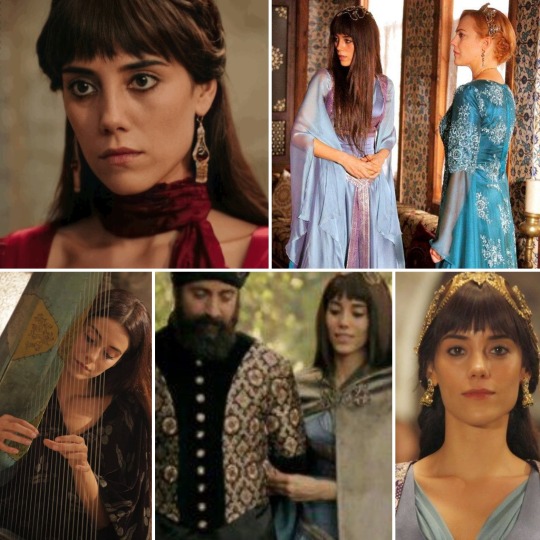
Huricihan Sultan
In the series, Huricihan was the daughter of Ibrahim Pasha and Hatice Sultan, who grew up in the palace of Beyhan Sultan after the death of her parents. From there she returned to Istanbul, where she fell in love with her first cousin, Prince Bayezid. Their love became a relationship and then marriage without the Sultan’s permission. Huricihan became the head of Bayezid's harem and soon her relationship with Hürrem and Suleiman slowly became better. Huricihan's end eventually was brought by Prince Selim's concubine, Nurbanu, who knocked her out in the heat of a dispute, killing her.
In reality, Hatice and Ibrahim Pasha were never married, so they didn't have children either together, so Huricihan never existed. If she had existed, for the reasons already mentioned, it would have been utterly inconceivable for Bayezid to marry her, either secretly or openly. Especially knowing that Bayezid had never had a favourite singled out concubine, as all of his children were born to different women. With a background like this, it’s unlikely he’d ever wanted to marry anyone. Although Hatice Sultan did indeed have a daughter, she was born between 1510 and 1515, so she was well ahead of Bayezid in age, and of course she had nothing to do with the prince and was not even called Huricihan.

Mihrünissa Hatun
In the series, Mihrünissa was the daughter of Hayreddin Barbarossa the Head of the Fleet, whom her father sent to Prince Mustafa as a consultant. Later, the two young person fell in love with each other and married without the Sultan's knowledge. In time, Mihrünissa also gave birth to Mustafa's son Mehmed. After Prince Mustafa and his son Mehmed were executed, Mihrünissa went to the capital and cut her own throat before Hürrem's eyes.
In reality, for the reasons already detailed several times above, no prince could marry anyone, so Mustafa also never married. In addition, Barbarossa never had a daughter named Mihrünissa and Hayreddin Pasha was never a supporter of Prince Mustafa. However, even assuming that Mihrünissa existed, there is no chance that she could have committed suicide before Hürrem's eyes. Prince Mustafa's harem retired to Bursa, so that no member of the harem could travel to the capital, especially not to the palace and kill herself in front of Hürrem. So, in fact, the Mihrünissa storyline was just 100% fiction.
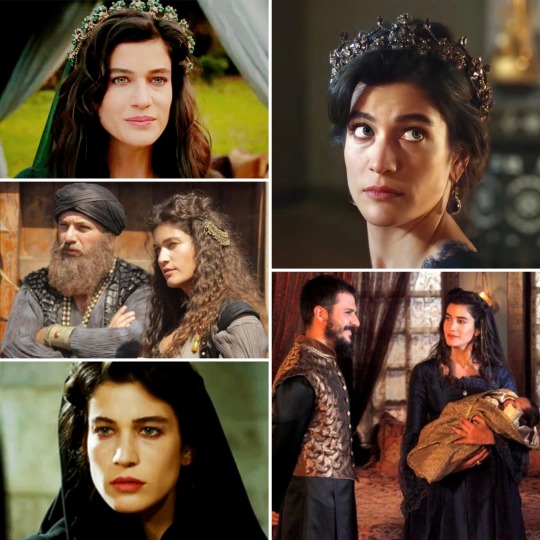
Nazenin Hatun
In the series, Nazenin arrived in Istanbul with Nurbanu, where Hürrem, who was struggling with menopause, sent her to the sultan herself. Nazenin thus became the sultan's concubine and soon gave birth to a daughter, Raziye Sultan. Eventually, on Hürrem's instructions, she was killed by Nurbanu.
In reality, as I have said many times, Suleiman was loyal to Hürrem. In addition, after the birth of Prince Cihangir in 1531/2, Suleiman had no more children, neither to Hürrem nor to anyone else. It is true that he had a daughter named Raziye, however, the child died in 1520 at the age of a few years as a result of an epidemic.
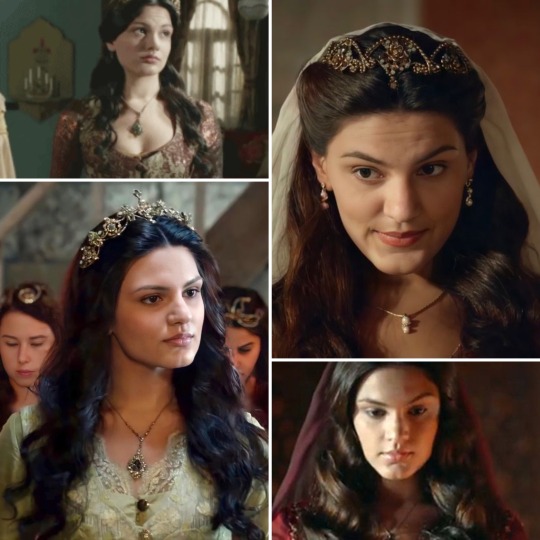
Surprising realities
After many fictional characters, one would think that all eunuchs and kalfas were fictional characters, as we know quite a bit about the harem. However, this is not true! There were some historically inspired characters, such as Gazanfer Agha, who, although existed and was one of the most influential eunuchs ever, was not a loyal man of Nurbanu, but Sultan Selim II. Gazanfer reached the peak of his career, by the way, during the reign of Safiye Sultan.
Similarly historical was Canfeda Hatun, who was Nurbanu’s most loyal servant and one of the most influential kalfas of her era. True, Canfeda’s character in the series was a fusion of two loyal servants of historic Nurbanu. In her young age, in the princely harem of Selim, Nurbanu became acquainted not with Canfeda but with another kalfa, who remained her faithful servant for the rest of her life. Canfeda only became Nurbanu’s main supporter during Selim’s reign.
Like them, Afife Hatun’s character was partly real also. Sultan Suleiman's wetnurse was really called Afife and the sultan always kept in touch with the woman. However, Afife Hatun never moved to Istanbul to rule the Sultan’s harem, but lived a simple life.
Gracia Mendes Nasi was introduced last season as a wealthy Portuguese Jewish woman who helped Portuguese refugees get to Istanbul. Later, Gracia became the lover of Grand Vizier Rüstem Pasha, which made her an enemy of Mihrimah Sultan. In reality, Gracia Mendes was a very benevolent soul who was committed to Jewish traditions and her Jewish brothers. She was never a lover of Rustem and an enemy of Mihrimah. However, like the series, Gracia actually enjoyed the Sultan’s support and, with his help, she made great improvements in Istanbul’s Jewish Quarter and helped many refugees start a new life in the Ottoman Empire.
One of the most interesting guest actors of the last season of the series was Anna Jagello, the daughter of the former King of Poland, the sister of the new King of Poland. Although the woman was a real historical figure, the historical Anna never traveled to Istanbul and never corresponded with Hürrem Sultan. However, Hürrem exchanged letters several times with Anna's mother Bona Sforza, Anna's father, King Sigismund I of Poland, and Anna's brother, the later Zsigmond Ágost II king of Poland, and even Anna's sisterm Isabella, the Hungarian queen. Thanks to the intercession of Hürrem, the relationship between the Kingdom of Poland and the Ottoman Empire was quite good and almost friendly during Suleiman's reign.
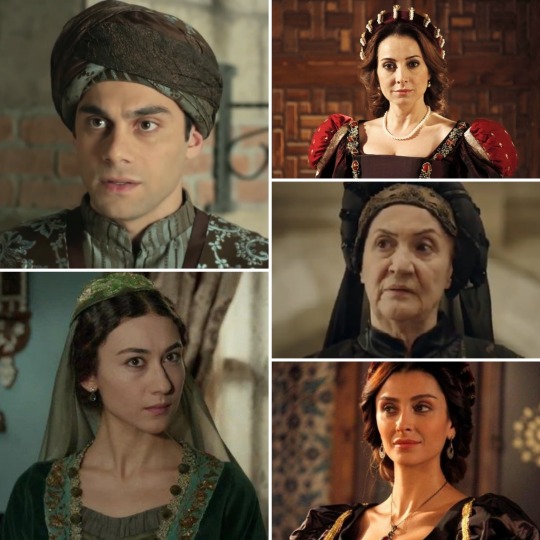
* * *
Egy kis karácsonyi meglepetés poszt következik. Youtube-on az egyik legnépszerűbb videóm az volt, amelyben a nem történelmi karaktereket gyűjtöttem össze, elmagyarázva, mennyire voltak kitaláltak, mennyire volt mögöttük egy-egy valós történelmi személy, mint ihlető. Most karácsony alkalmából szeretném nektek összefoglalni a Muhteşem Yüzyil sorozat főbb kitalált karaktereit és történetüket.
A Muhteşem Yüzyil sorozatban több kitalált karakter is jelen volt, sokan már az első percektől kezdve. Egyes kitalált karakterek jelenléte megbocsátható volt, hiszen nagyon kevés részlet maradt ránk a Szulejmán háremében jelenlévő személyekről. Így például Sümbül Aga, Gül Aga, Mercan Aga és más eunuchok karakterei bár nem valódi személyeket keltenek életre, szükségesek voltak a sorozat dramaturgiája szempontjából. Sümbül karaktere volt a legfontosabb az eunuchok között és talán emiatt sokan gondolhatjuk úgy, hogy Hürremnek a valóságban is volt egy ilyen közeli barátja a fő eunuch személyében. Azonban ez nem igaz. Szulejmán uralkodása alatt rengeteg főeunuch váltotta egymást és egyikről sem ismert, hogy különösebben közel álltak volna Hürremhez. Hürrem közeli szolgálói közül csupán egy ismert név szerint, egy Nevbahar nevű nő. Sümbülhöz hasonló volt Nigar Kalfa, Gülsah Hatun, Fidan Hatun, Daye Hatun, Fahriye Kalfa karaktere is. Egyikük sem valós személy volt, ám bizonyosan minden szultánának megvoltak a saját megbízható szolgálói, ahogy ezt a sorozatban is mutatták. Hasonlóan az eunuchokhoz és kalfákhoz megbocsátható füllentésnek tekinthetőek Musztafa herceg és Bayezid herceg ágyasai is, Ayşe, Rana, Defne vagy Rumeysa Hatun. A két herceg asszonyairól ugyanis semmit sem tudunk, egyiküknek sem volt kiemelt jelentőségű főágyasa, gyermekeik más-más nőktől születtek.

Voltak azonban olyan karakterek is, akiket csupán a dráma kedvéért írtak bele a történetbe. Az, hogy ezek közül melyik karakter mennyire volt elfogadható, azt mindenki maga döntse el és nyugodtan írja meg kommentben itt vagy más platformon, hogy mit gondol róluk! Következzék hát a várva várt lista:
Sadika Hatun
Sadika a sorozatban egy magyar nő volt, akinek férjét az esküvőjük napján megölte Szulejmán szultán. Sadika ezek után a magyar király, II. Lajos parancsára Isztambulba utazott, hogy ott személyesen bosszulja meg férje halálát. Matrakci Nasuh Efendi aztán egy véletlen folytán megismerkedik a lánnyal és segít neki bekerülni a hárembe, ahol azonnal Ayşe Hafsa Valide Sultan szolgálatába áll, majd Hatice Sultan főszolgálója lesz. Menetközben természetesen többször is Szulejmán ágyának közelébe kerül, majd lehetősége nyílik a szultánra támadni. Azonban nem jár sikerrel, Szulejmán életben marad, Sadikát pedig a Boszporuszba fojtják.
A valóságban ez a történetszál egyáltalán nem lenne lehetséges. Ha feltételeznénk is azt, hogy Sadika valóban létezett és Szulejmán valóban megölte a férjét, akkor sem állt volna módjába bejutni a szultáni hárembe és bosszút állni. Egyrészt Sadika férjezett asszony volt már, felnőtt nő. A hárembe nem kerülhettek be ilyen nők, csupán szűz, gyermeklányokból válhattak a szultán ágyasai. Mindazonáltal ha Sadika valahogy mégis bekerült volna a hárembe hosszadalmas oktatás várt volna rá, mielőtt a Valide Sultan szolgálatába állhatott volna. Előfordulhatott ugyan néhány kivételes eset, amikor idősebb vagy nem szűz nőket akartak volna a szultánnak ajándékozni, azonban ezek különleges esetek. Ilyen volt például, amikor Hayreddin Barbarossa el akarta rabolni a messze földön ismert, gyönyörű Giulia Gonzagát, megözvegyült itáliai nemesasszonyt, hogy a szultán háremébe küldje ajándéknak. Végül nem járt sikerrel, ám ha sikerrel járt volna is, nem tudni, hogy a szultán valaha is ágyba vitte volna-e a nőt.
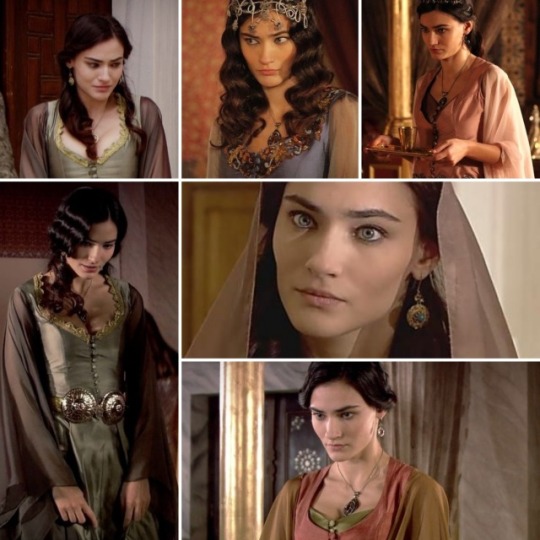
Leo
A sorozatban Leo Hürrem fiatalkori szerelme volt, aki azzal a céllal érkezett Isztambulba, hogy megtalálja egykori kedvesét. Leo tehetséges művész, aki Nasuh Efendi segítségével (ahh Nasuh csupa jó embert juttatott a szultán közelébe…) Szulejmán szultán és Pargali Ibrahim festője lesz. Egykori viszonya Hürremmel hamarosan kiderül Pargali Ibrahim számára, aki ezzel próbálja zsarolni Hürremet. Hürrem többször könyörög Leonak, hogy hagyja el a fővárost, de a szerelmes férfi marad, ami végül halálához vezet.
A valóságban Hürrem – és minden más ágyas – még kislányként került oszmán fogságba, tehát kizárt, hogy szerelmük vagy vőlegényük lett volna, ha pedig mégis, az sosem tudott volna rájuk találni. Nasuh Efendi, pedig aki a sorozat egyik legnagyobb baleke – ugyanakkor legkedvesebb karaktere – a valóságban egyáltalán nem ilyen volt, hanem egy csodálatos tudós, aki egyébként nem állt ilyen közeli barátságban sem Szulejmán szultánnal, sem Pargali Ibrahimmal.
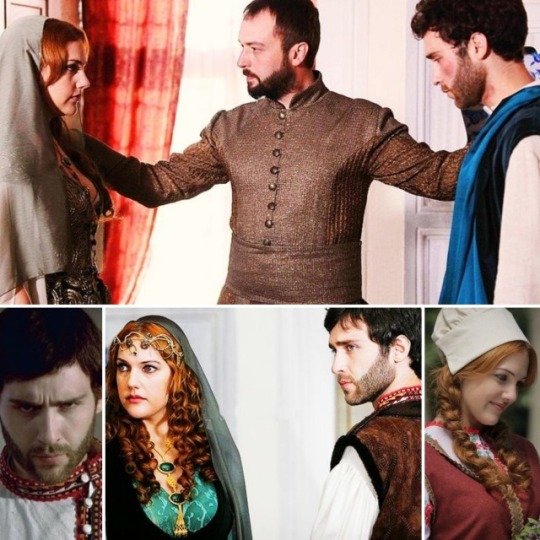
Izabella Hercegnő
Izabella Fortuna hercegnő a sorozatban egy spanyol nemes hölgy volt, aki éppen jövendőbeli férjéhez, az osztrák herceghez tartott hajón, mikor az oszmán kalózok elragadták és Isztambulba vitték Szulejmán szultán elé. Először Szulejmán politikai okokból érdeklődött csupán a hercegnő iránt, később azonban beleszeretett. Izabella hercegnő eleinte minden porcikájával ellenállt Szulejmán közeledésének, idővel azonban beleszeretett a szultánba és a szeretője lett. Ezt természetesen Hürrem szultána nem állhatta és mindent megtett, hogy megszabaduljon a hercegnőtől, akit végül Szulejmán küldött el.
A valóságban természetesen elképzelhetetlen lett volna egy ilyen szituáció. Ha feltételezzük is, hogy Izabella létezett és a kalózok fogságába esett, egyetlen katolikus hitben nevelt hercegnő sem vált volna szabad akaratából a szultán ágyasává, előbb lett volna öngyilkos. Azt se felejtsük el, hogy Szulejmán az 1520-as évektől kezdve hűséges volt Hürremhez, a valóságban nem volt egyetlen nő sem, aki éket verhetett volna közéjük több évtizedes kapcsolatuk alatt. Másrészről pedig Izabella Fortuna sosem létezett. Meglepő azonban, hogy valós karakterről mintázhatták. Létezett egy Kasztíliai Izabella ebben a korban, aki 1518-ban született az özvegy aragóniai királyné Germaine Foix és V. Károly gyermekeként, azonban sosem esett oszmán kalózok csapdájába és sosem volt az osztrák herceg menyasszonya. Izabella létezését egész életében titokban tartották szülei, csupán édesanyja végrendeletéből derült fény arra, hogy valaha is létezett. Innen tudni azt is, hogy Izabella fiatalon elhunyt 1537-ben.
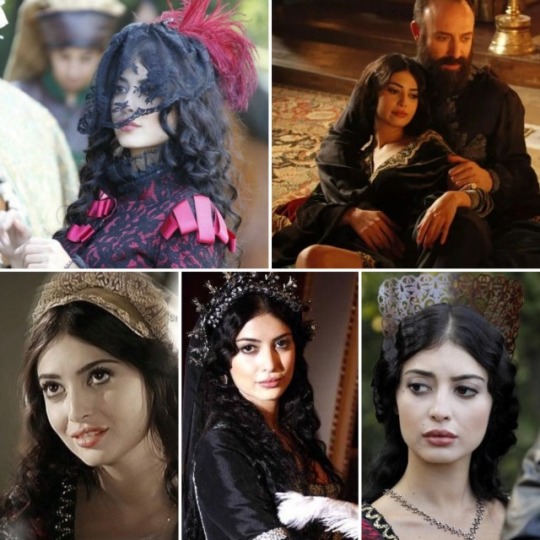
Aybige Hatun
A sorozatban Aybige Ayşe Hafsa Sultan unokahúga volt, a krími Sahib Giray kán lánya. Aybige eredetileg csak látogatóba érkezett Isztambulba, később azonban nagynénje szerette volna őt kedvenc unokája, Musztafa herceg feleségeként látni. Aybige azonban Bali Bégbe volt szerelmes és Musztafa is más után vágyakozott. Bali Béget végül majdnem kivégezték a szerelmük miatt, Aybige pedig apjával visszatért a Krímre.
Aybige történetszála szinte minden létező ponton hibádzik. Először is, Ayşe Hafsa sosem volt a Krími kán testvére, tehát a krími kán lánya sem lehetett az unokahúga. Emellett Sahib Giray kánnak bár több lánya volt, egyiket sem hívták Aybigének és egyik lánya sem utazott sosem Isztambulba. Az egész történetszál egyetlen igaz pontja, hogy Sahib Giray kán tényleg együttműködött Szulejmán szultánnal annak moldáv háborújában. Fontos megemlíteni ezen a ponton Bali Béget is. Bali Bég bár valós történelmi személy volt, de a legkisebb egyezés sincs a történelmi Bali Bég és a sorozat Bali Bége között. A valódi Bali Bég nem egy romantikus fickó volt, aki minden második nőbe beleszeretett, és akiért bolondultak a nők. Bali Bég egy kegyetlen hadvezér volt. És ha már Bali Bég szóba jött, ejtsünk néhány szót Musztafa hercegről is. Az ötlet, hogy Musztafát egy kán lányához akarják adni teljesen abszurd! II. Mehmed szultán uralkodása óta tilos volt a hercegeknek házasságot kötni, így Musztafa herceg sem köthetett senkivel házasságot. Az pedig, hogy Szulejmán támogatta volna az ötletet, már ha egyáltalán felmerült volna egy ilyen házasság, még nagyobb abszurdum. Szulejmán nem Musztafát akarta örökösének, így sosem adott volna a kezébe akkora hatalmat, mint a krími kán támogatása.

Firuze Hatun
A sorozatban Firuze egy perzsa kém volt, aki csodálatos képességeivel gyógyítani tudta a beteges Cihangir herceg fájdalmait, amivel kiérdemelte Hürrem szeretetét. Firuze azonban rút módon hálálta meg Hürrem kedvességét, ugyanis Szulejmán titkos szeretője lett, akibe a szultán halálosan beleszeretett. Végül Hürrem csak egy hajszállal volt képes felülkerekedni Firuzén, akit végül száműztek a palotából, így visszatérhetett Perzsiába.
A valóságban Szulejmán hűséges volt Hürremhez, monogám kapcsolatban éltek. Ha előfordult is alkalomadtán egy-egy egyéjszakás kaland, Szulejmán soha nem szeretett bele más nőbe, csak Hürremet szerette. Így a Firuze történetszál már itt el is bukott. A tény, hogy Firuze perzsa kém lett volna érdekes felvetés, bizonyára akadtak kémek minden birodalom királyi udvarába, azonban ők valószínűleg nem az ágyasok között rejtőztek. Az eunuchok például, sokkal nagyobb szabadsággal mozogtak, sokkal könnyebben lefizethetők voltak…
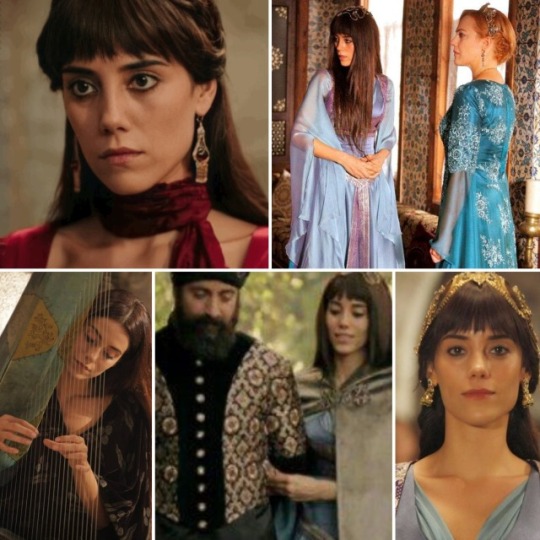
Huricihan Sultan
A sorozatban Huricihan Ibrahim Pasa és Hatice Sultan lánya volt, aki szülei halála után Beyhan Sultan palotájában nevelkedett. Onnan tért vissza Isztambulba, ahol beleszeretett elsőunokatestvérébe, Bayezid hercegbe. Szerelmükből kapcsolat, majd házasság lett a szultán engedélye nélkül. Huricihan Bayezid háremének feje lett és kapcsolata lassanként rendbejött Hürremmel és a szultánnal is. Huricihan végzete végül Szelim herceg ágyasa, Nurbanu lett, aki egy vita hevében leütötte őt, ezzel megölve.
A valóságban Hatice és Ibrahim Pasa sosem voltak házasok, így gyermekük sem született, tehát Huricihan sosem létezett. Ha létezett volna is, a már korábban említett okokból teljesen elképzelhetetlen lett volna, hogy Bayezid feleségül vegye őt akár titokban, akár nyíltan. Különösen tudva, hogy Bayezidnek nem volt sosem kiemelt ágyasa, minden gyermeke más nőtől született. Ilyen háttérrel nem valószínű, hogy valaha is feleségül akart volna venni bárkit. Hatice Sultannak bár valóban volt egy lánya, az 1510-1515 között született, így korban jóval megelőzte Bayezidet, és természetesen sosem volt semmi köze a herceghez és nem is Huricihannak hívták.
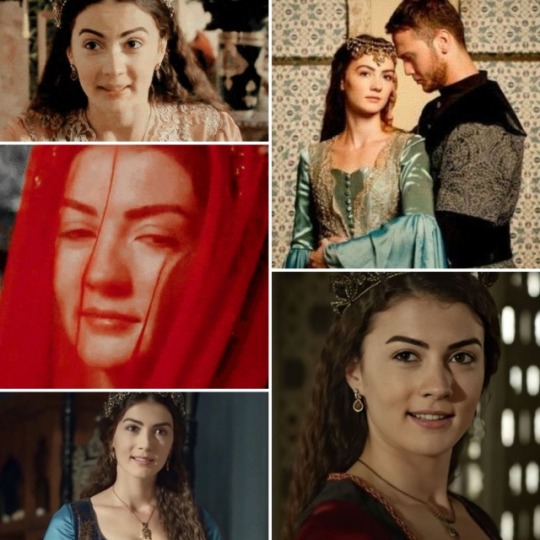
Mihrünissa Hatun
A sorozatban Mihrünissa Hayreddin Barbarossa flotta parancsnok lánya volt, akit édesapja küldött Musztafa herceg mellé tanácsadónak. Később a két fiatal egymásba szeretett és a szultán tudta nélkül egybe keltek. Idővel Mihrünissa életet adott Musztafa fiának, Mehmednek is. Miután Musztafa herceget és vele együtt fiát, Mehmedet is kivégezték, Mihrünissa a fővárosba ment és Hürrem szeme láttára elvágta a saját torkát.
A valóságban a már fent többszörösen részletezett okok miatt egy herceg sem köthetett házasságot, így Musztafa sem nősült meg soha. Emellett Barbarossának sosem volt Mihrünissa nevű lánya és Hayreddin Pasa sohasem volt Musztafa herceg támogatója. Ha azonban feltételeznénk is, hogy Mihrünissa létezett, nincs arra esély, hogy Hürrem szeme láttára lehetett volna öngyilkos. Musztafa herceg háreme Bursába vonult vissza, így a hárem egyik tagja sem utazhatott egyetlen percre sem a fővárosba, nemhogy a palotába, Hürrem elé. Így tulajdonképpen a Mihrünissa történet-szál 100%-ban kitaláció volt.

Nazenin Hatun
A sorozatban Nazenin Nurbanuval együtt érkezett Isztambulba, ahol aztán a menopauzával küszködő Hürrem maga küldte őt a szultán elé. Nazenin így a szultán ágyasa lett és hamarosan egy lánygyermeknek, Raziye Sultannak adott életet. Végül Hürrem utasítására Nurbanu ölte meg.
A valóságban, mint már sokszor mondtam, Szulejmán hűséges volt Hürremhez. Emellett Cihangir herceg 1531/2-es születése után Szulejmán nem nemzett több gyermeket, sem Hürremnek sem másnak. Az igaz, hogy volt egy Raziye nevű kislánya, azonban a gyermek 1520-ban néhány éves korában elhunyt egy járvány következtében.
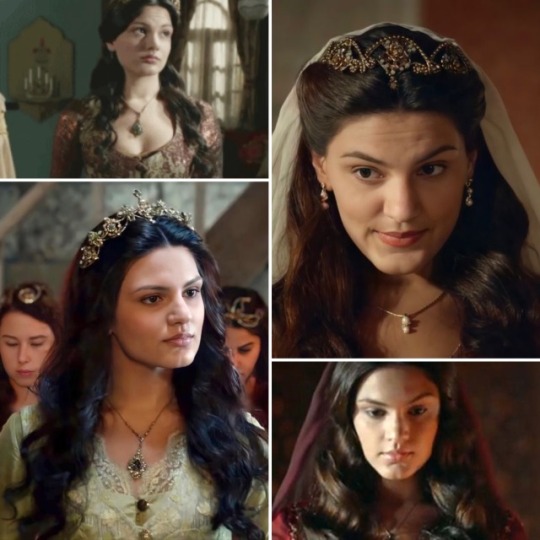
Meglepő valóságok
A sok kitalált karakter után azt gondolhatnánk, hogy az összes eunuch és kalfa kitalált karakter volt, hiszen meglehetősen keveset tudunk a háremről. Azonban ez nem igaz! Volt néhány történelmi ihletésű karakter, mint például Gazanfer Aga, aki bár létezett, és a valaha volt egyik legbefolyásosabb eunuch volt, nem Nurbanu hű embere volt, hanem II. Szelim szultáné. Gazanfer pályája csúcsát egyébként Safiye Sultan uralkodása alatt érte el.
Hasonlóan valós volt Canfeda Hatun is, aki Nurbanu leghűségesebb szolgálója volt és az egyik legbefolyásosabb kalfája korának. Igaz, Canfeda sorozatbeli karaktere, a történelmi Nurbanu két hűséges szolgálójának ötvözéseként született meg. Nurbanu fiatal korában, Szelim hercegi háremében nem Canfedával, hanem egy másik kalfával ismerkedett meg, aki élete végéig hűséges szolgálója maradt. Canfeda csak Szelim uralkodása alatt került képbe és vált Nurbanu fő segítőjévé.
Hozzájuk hasonlóan Afife Hatun karaktere is részben valós volt. Szulejmán szultán szoptatósdajkáját tényleg Afifének hívták és a szultán mindig tartotta a kapcsolatot az asszonnyal. Azonban Afife Hatun sosem költözött Isztambulba, hogy irányítsa a szultáni háremet, hanem egyszerű életet élt.
Gracia Mendes Nasi az utolsó évadban került bemutatásra, mint gazdag portugál zsidóasszony, aki portugál menekülteknek segített Isztambulba jutni. Később Gracia a nagyvezír Rüsztem Pasa szeretője lett, aminek köszönhetően szembe került Mihrimah szultánával. A valóságban Gracia Mendes igen jótét lélek volt, aki elkötelezett volt a zsidó hagyományok és zsidó testvérei iránt. Sosem volt Rüsztem szeretője és Mihrimah ellensége. Azonban a sorozathoz hasonlóan, Gracia a valóságban is élvezte a szultán támogatását és segítségével nagy fejlesztéseket vitt véghez Isztambul zsidó negyedében és nagyon sok menekültnek segített új életet kezdeni az Oszmán Birodalomban.
A sorozat utolsó évadának egyik legérdekesebb vendégszereplője Jagelló Anna volt, az egykori lengyel király lánya, az új lengyel király testvére. Bár az asszony valós történelmi személy volt, a történelmi Anna sosem utazott Isztambulba és sosem levelezett Hürrem szultánával. Azonban Hürrem többször is váltott levelet Anna édesanyjával Bona Sforzával, Anna édesapjával, I. Zsigmond lengyel királlyal, valamint Anna testvérével, a későbbi II. Zsigmond Ágost lengyel királlyal, sőt Anna másik testvérével Izabella, magyar királynővel is. Hürrem közbenjárásának köszönhetően Szulejmán uralkodása alatt meglehetősen jó, szinte baráti volt a viszony a Lengyel Királyság és az Oszmán Birodalom között.
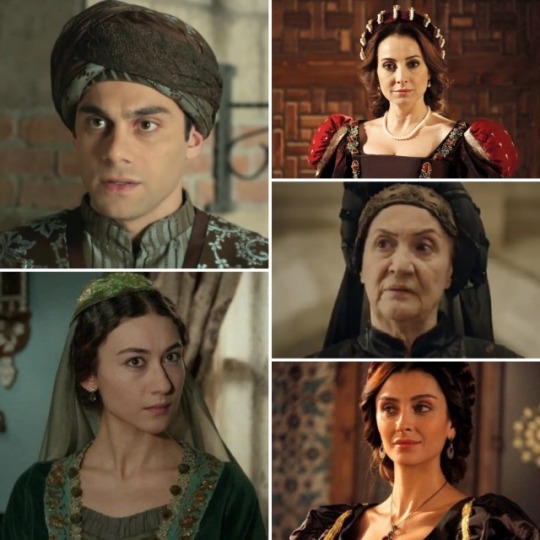
#selim ii#gazanfer agha#gazanfer#suleiman the magnificent#safiye sultan#suleiman i#suleyman i#haseki hürrem sultan#hürrem sultan#nurbanu sultan#aybige hatun#ayse hafsa#ayse hafsa sultan#princess isabella#firuze#firuze hatun
91 notes
·
View notes
Text
OK...so...İbrahim did something THAT cruel to Hürrem and EVERYONE just went along with it.
WOW.
I thought better of İbrahim, Sümbül Agha and Nigar Kalfa. I guess I was wrong.
That was just plain mean.
#magnificent century#suleiman the magnificent#muhteşem yüzyıl#hürrem#hürrem sultan#ibrahim#ibrahim pargalı#yes this is about the gülnihal thing
11 notes
·
View notes
Photo
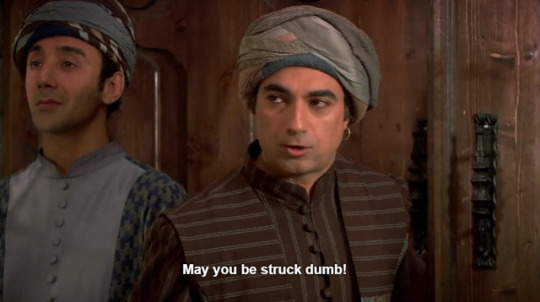

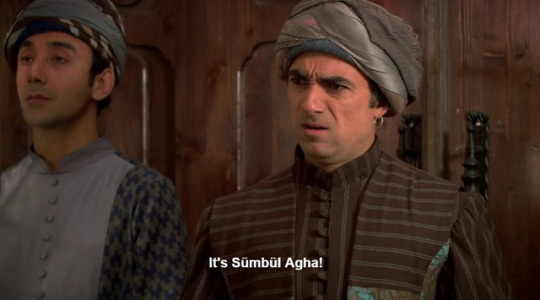
sümbül agha is so done with white people’s shit
6 notes
·
View notes
Text
Interesting Papers for Week 33, 2020
Wireless recording from unrestrained monkeys reveals motor goal encoding beyond immediate reach in frontoparietal cortex. Berger, M., Agha, N. S., & Gail, A. (2020). eLife, 9, e51322.
A Neuro-computational Account of Arbitration between Choice Imitation and Goal Emulation during Human Observational Learning. Charpentier, C. J., Iigaya, K., & O’Doherty, J. P. (2020). Neuron, 106(4), 687-699.e7.
Perfect Prediction in normal form: Superrational thinking extended to non-symmetric games. Fourny, G. (2020). Journal of Mathematical Psychology, 96, 102332.
Assessing multisensory integration and estimating speed of processing with the dual-presentation timing task: Model and data. García-Pérez, M. A., & Alcalá-Quintana, R. (2020). Journal of Mathematical Psychology, 96, 102351.
Whole-Neuron Synaptic Mapping Reveals Spatially Precise Excitatory/Inhibitory Balance Limiting Dendritic and Somatic Spiking. Iascone, D. M., Li, Y., Sümbül, U., Doron, M., Chen, H., Andreu, V., … Polleux, F. (2020). Neuron, 106(4), 566-578.e8.
Acetylcholine acts on songbird premotor circuitry to invigorate vocal output. Jaffe, P. I., & Brainard, M. S. (2020). eLife, 9, e53288.
Efficient Communication in Distributed Simulations of Spiking Neuronal Networks With Gap Junctions. Jordan, J., Helias, M., Diesmann, M., & Kunkel, S. (2020). Frontiers in Neuroinformatics, 14, 12.
Retrospective surprise: A computational component for active inference. Katahira, K., Kunisato, Y., Okimura, T., & Yamashita, Y. (2020). Journal of Mathematical Psychology, 96, 102347.
Let’s get it together: Infants generate visual predictions based on collaborative goals. Krogh-Jespersen, S., Henderson, A. M. E., & Woodward, A. L. (2020). Infant Behavior and Development, 59, 101446.
Tracking the Mind’s Eye: Primate Gaze Behavior during Virtual Visuomotor Navigation Reflects Belief Dynamics. Lakshminarasimhan, K. J., Avila, E., Neyhart, E., DeAngelis, G. C., Pitkow, X., & Angelaki, D. E. (2020). Neuron, 106(4), 662-674.e5.
The role of context in experiments and models of multisensory decision making. Liu, Y., & Otto, T. U. (2020). Journal of Mathematical Psychology, 96, 102352.
Learning New Feedforward Motor Commands Based on Feedback Responses. Maeda, R. S., Gribble, P. L., & Pruszynski, J. A. (2020). Current Biology, 30(10), 1941-1948.e3.
Deep active inference as variational policy gradients. Millidge, B. (2020). Journal of Mathematical Psychology, 96, 102348.
Cholinergic Switch between Two Types of Slow Waves in Cerebral Cortex. Nghiem, T.-A. E., Tort-Colet, N., Górski, T., Ferrari, U., Moghimyfiroozabad, S., Goldman, J. S., … Destexhe, A. (2020). Cerebral Cortex, 30(6), 3451–3466.
From Near-Optimal Bayesian Integration to Neuromorphic Hardware: A Neural Network Model of Multisensory Integration. Oess, T., Löhr, M. P. R., Schmid, D., Ernst, M. O., & Neumann, H. (2020). Frontiers in Neurorobotics, 14, 29.
Correlated racing evidence accumulator models. Reynolds, A., Kvam, P. D., Osth, A. F., & Heathcote, A. (2020). Journal of Mathematical Psychology, 96, 102331.
Upper Limit on the Thermodynamic Information Content of an Action Potential. Street, S. (2020). Frontiers in Computational Neuroscience, 14, 37.
Population coupling predicts the plasticity of stimulus responses in cortical circuits. Sweeney, Y., & Clopath, C. (2020). eLife, 9, e56053.
A Cortico-Collicular Amplification Mechanism for Gap Detection. Weible, A. P., Yavorska, I., & Wehr, M. (2020). Cerebral Cortex, 30(6), 3590–3607.
Rapid Aversive and Memory Trace Learning during Route Navigation in Desert Ants. Wystrach, A., Buehlmann, C., Schwarz, S., Cheng, K., & Graham, P. (2020). Current Biology, 30(10), 1927-1933.e2.
#science#Neuroscience#computational neuroscience#Brain science#research#cognition#cognitive science#neurons#neurobiology#psychophysics#scientific publications#decision making#active inference
0 notes
Text
I am looking at the Turkish comments under Episode 113 and people are shocked at Sümbül’s backstory? How did they think that the eunuchs were made??
This show’s viewers can’t put two and two together about the system in place. That’s probably why they think that Hürrem and Ibrahim’s backstories are especially similar, they don’t get that almost every character is an enslaved convert lol.
15 notes
·
View notes
Text
Okay but the fact that Cevher didn’t immediately run away because she wanted to give an excuse to Sümbül so that he wouldn’t be concerned for her 😭😭. This is actually well-done. One of the more well-done subplots of this show.
She actually loved him back.
9 notes
·
View notes
Text
A comment about Sümbül and Hürrem asfghhh

8 notes
·
View notes
Text
Some details about Sümbül’s backstory:
1) The ones who castrated him are posited as Coptic priests. Is this historically accurate? I ask because I honestly don’t know.
2) The food that the priests give him to deceive him looks like a yellow Turkish Delight. If it really is so I am glad to see that Yılmaz Şahin didn’t completely forget about Leo.
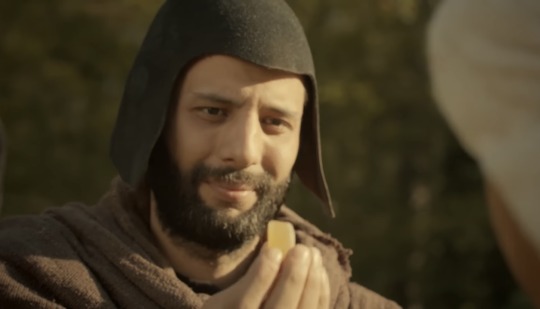
7 notes
·
View notes
Text
I love Season 1 Sümbül asfhhjkkk
3 notes
·
View notes
Text
@stealing-your-kittens is right. Gülnihal/Sümbül rocks. A subtle requited romance between two “servants” (one of them a eunuch) that doesn’t serve the aims or arcs of any of the higher ups. No unnecessary romanticization or excessive pervy sexualization or stalking that plagues almost all other romance arcs in this show, just pure feelings just conveyed with eyes and concern for the other. Just awesome for the sake of awesome.
I do wonder how it would go if Burcu Tuna were in Season 2. Maybe it was better that she wasn’t and it didn’t get a chance to be ruined or to be excessively tragic.
9 notes
·
View notes
Text
I do understand people who voted for Sümbül Ağa in @fabrizio-art ‘s poll when I watch segments of Ufak Tefek Cinayetler.
3 notes
·
View notes
Text
4 notes
·
View notes